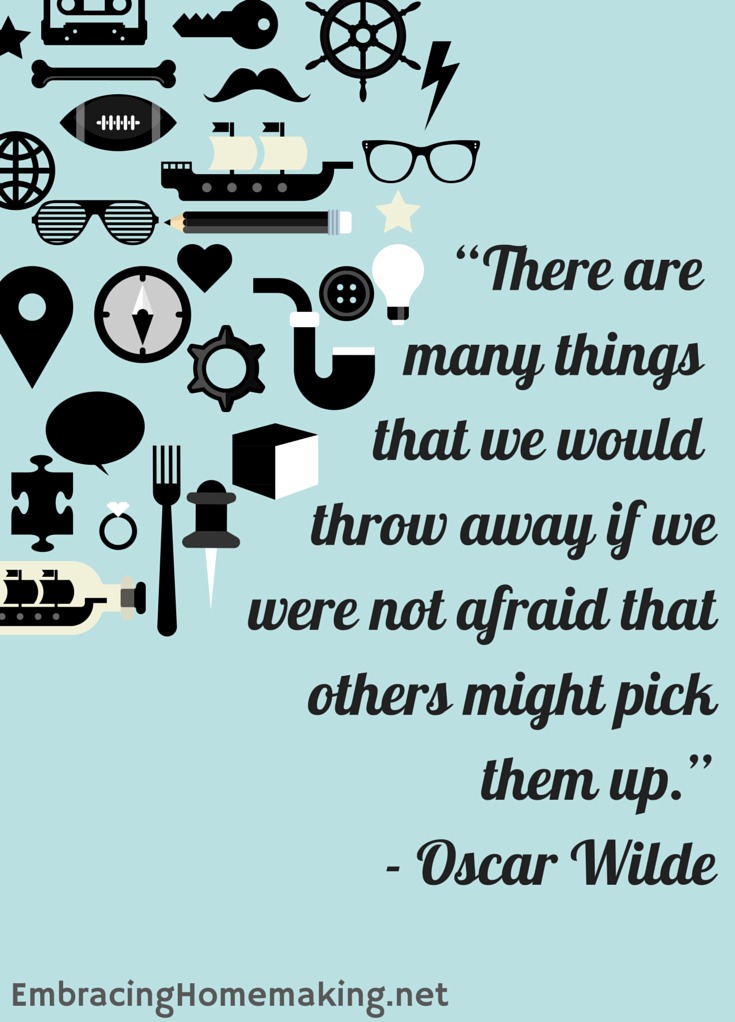200 Things to Throw Away

Living with less isn’t about the number of things you get rid of it’s about living with enough to be content and getting rid of the rest. The rest is just clutter, unnecessary, energy-draining clutter.
Here is a list of 200 Things to Throw Away. This list isn’t a list of things that I have gotten rid of myself but of things that I want to will get rid of!
I’ll be tackling this list ten or so items a week and I look forward to a less-cluttered house at the end of it.
As you look ahead at this list I want you to remember two things:
1.) Remember you can sell, donate, recycle or throw away. Knowing that I’m allowing someone else to enjoy my things makes it easier for me to let them go.
2.) Keep things that make you feel good. If it doesn’t make you feel happy when you look at it, get rid of it quickly. Surround yourself with things you enjoy.
Now on to the list:
1. Old product boxes (Apple products, TV, etc.)
2. Hangers from the dry cleaners
3. Plastic hangers from the store
4. Expired make up
5. Half-finished projects…you know the one!
6. Magazines
7. Old emery boards (buy a nice glass one and be done with those scratchy things!)
8. Old paint (Visit Earth911.com to find a place to dispose of it safely)
9. Ugly undergarments you hate to wear (You have those “just in case” pairs too, right?)
10. Bills, taxes, paperwork over 7 years old
11. Socks with holes or without mates…also those lonely socks that have holes too. 
12. Extra cups and mugs – How many does your family use in a regular dishwasher load? Add a few more for company and be done with the rest.
13. Books you’ve never read or will never read again
14. Old technology (8 tracks, floppy discs, VHS tapes w/o a player, etc.)
15. Unloved toys
16.Cleaning rags – You only need a few before you’ll wash them again, right?
17. Tea light candles – Use them or lose them.
18. Take out menus you never look at
19. Old greeting cards (Save the super sentimental ones and recycle the rest)
20. Outdated over the counter drugs and vitamins
21. Old sneakers (Recycle through Nike)
22. Plastic cutlery
23. Old spices – Spices don’t actually spoil but they lose their potency. A good rule of thumb is 1-2 years for seasoning; 1-3 for herbs and ground spices; and up to 4 years for whole spices.
24. Duplicate power cords (USB, etc. We have 3 vTech ones for the kiddos’ toys but only need one)
25. Bobby pins
26. Games with missing pieces
27. Dried up nail polish bottles
28. Video games you’ll never play again
29. Recalled baby items (carseats, cribs, etc.)
30. Jewelry you don’t wear
31. Expired food in your freezer/pantry
32. Rugs or home decor you haven’t used since you redecorated
33. Unused perfumes and cologne
34. Old towels that make you cringe when you look at them
35. Extension cords (Am I the only one who has a bazillion of these?)
36. Extra sets of bed linens – two per bed tops
37. Unused plastic containers – especially those without a lid and those old plastic containers. Avoid containers with recycle codes 3 or 7 as they may contain BPA.
38. Old bills (Switch to online banking and stop the clutter before it comes in your home)
39. Paychecks older than 2 years
40. Stretched out hair ties
41. Matches you never use (Maybe save a few in case of a power outage)
42. Old newspapers
43. Expired Rx meds (Visit fda.gov for proper ways to dispose of them)
44. Extra pillows
45. Ticket stubs (Sentimental like myself? Store in a scrapbook or fill a mug with old stubs)
46. Make up you’ll try “one day” If you’ve owned if for more than 2 weeks without trying it, toss it.
47. Clothes that are more than 2 sizes too small. Don’t give up on your weight loss dream but WHEN you do lose that weight go and buy new clothes to reward yourself.
48. Things you’ve bought have haven’t returned yet (Return them, sell, or donate them)
49. White-out bottles – You know you don’t need it!
50. Unneeded notebooks
51. Pens and pencils – Keep your favorites and let go of the rest
52. Little shampoo bottles from a hotel you went to 5 years ago
53. Knick knacks that don’t make you smile every time you see them
54. Cords that don’t belong to anything you currently own
55. Lose screws, nuts, bolts, etc. unless you happen to be a handy man who would actually reuse them one day
56. Kid’s old art projects (I have an upcoming post with loads of ideas on this so for now just set them aside)
57. Old party supplies
58. Old wedding favors (Keep a few, toss the rest)
59. Old Christmas cards of your family (Save a few, recycle the rest)
60. Holiday decor you never remember to set out (Thanksgiving turkey Aunt Sue gave you)
61. Holiday decor that you use once a year (ex. Easter deviled egg tray that collects dust 364 days of the year! Buy a lovely one that you can use for other holidays too.)
62. Cleaning supplies, laundry detergent, shampoo that you used once and didn’t like. Donate to a local shelter.
63. Flower pots. Plant a flower or toss the pot.
64. Watering cans if you don’t have flowers.
65. Too small kid’s clothing. Only save favorites if you’re saving for another child. Sell the rest while they’re still in style.
66. Extra buttons (If you don’t sew, toss them all. Reduce your supply if you will use a button in the next few months)
67. Old calendars
68. Unidentified frozen objects (Label ya’ll! Keep a Sharpie by the freezer for quick labeling)
69. Movies you’ll probably never watch again
70. Bags from the mall you might use one day (Keep only 1 if you must)
71. Multiple pair of scissors (One or two tops, right?)
72. More ear buds than you’ve got family members
73. Curling irons, crimpers (ha! flash back), or straighteners you don’t use
74. Highlighters unless you’ve used one in the past month, then save only that one
75. Travel mugs that leak, or are ugly, or that you don’t use because you have to hand wash it
76. Boxes – shoe boxes, diaper boxes, cereal boxes. Recycle and be free.
77. Samples of any kind – Use, donate, or trash.
78. Games you haven’t played in the last year
79. Tape measures – You know the rule, keep one and toss the rest.
80. Old phone covers, styluses, screen protectors, etc.
81. Misc. ribbons or string
82. Expired coupons
83. Organizers you bought to get organized that didn’t work
84. Belts that no longer fit, are worn, or are out of style
85. Duplicate kitchen utensils – Have you ever used three wisks at the same time before? Me neither.
86. Cookie cutters unless you’ve used them in the past year and foresee using them again
87. Rarely used cake pans – Our bakery supply store rents them for $2 a day. I no longer need to keep any on hand for those rare occasions I bake.
88. Old teeth whitening trays or strips. Use ’em up or toss ’em out.
89. Hard candy that you’re not sure where it came from or how long it’s been there
90. Unloved stuffed animals
91. Half used chap stick containers – Buy a new one! I LOVE my new EOS one with coconut milk.
92. Duplicate measuring cups and spoons
93. Old day planners (and current ones if you don’t use them!)
94. Candles – If it’s not lovely to look at and you’ll never burn it, let it go.
95. Mason jars (or baby food jars, spaghetti sauce jars, etc.) that you won’t use
96. Expired sunscreen
97. Staple remover – unless you can make a very compelling argument to keep yours.
98. Travel alarm clock – We have phones now.
99. Stress balls
100. Plug in air fresheners without a refill
101. Unloved dog toys
102. Extra USB flash drives – How many does one family need?
103. Promotional swag
104. Key chains you don’t use
105. Recipe books you don’t ever use
106. Push pins in the junk drawer just waiting for unsuspecting fingers
107. Keys that you don’t know what they go to
108. Lanyards, name tags, bags, etc. from previous conferences
109. Carabiners – Unless you rock climb, trust me, you won’t use them.
110. Lotions, face washes, serums that you don’t use
111. Random batteries you’re not sure where they came from
112. Multiple book marks – Unless you’re a book worm…you know what to do, toss them.
113. Combination locks – Chances are slim you’ll use one again but if you do, they’re cheap to replace.
114. Paper weights
115. Near empty bottles of bubbles or little numbs of side-walk chalk
116. Completed coloring books
117. Markers without lids and lids without markers
118. Goodie bag toys from previous birthday party celebrations
119. Empty bottles of anything
120. Puzzles
121. Old invitations
122. Travel brochures
123. Tissue paper/gift bags
124. Unused sticky notes
125. Extra shoe laces
126. Sticker’s from a precious yard sale
127. Hair products you don’t use
128. Take out chopsticks – Buy a reusable pair if you use them a lot
129. Old prescription glasses – Great donation for the Lions Club.
130. Old sunglasses – The cat eye is coming back but definitely toss those purple hued ones.
131. Worn out flip flops.
132. Magnets – Unless they are lovely or useful, discard.
133. Posters you’ll never display again
134. Excess decks of cards
135. Phone books
136. Broken Christmas lights
137. Notes/gifts from old romances
138. Hats you don’t wear or that look like you shouldn’t
139. Extra bubble wrap (or am I the only one who has a supply?)
140. Twisty ties (another one that hits close to home!)
141. Chip clips
142. Craft supplies for a project that has already been completed
143. Paper plates – Use them up!
144. Loyalty cards – use the key ring version or enter your number for even less clutter
145. Gift cards – go and enjoy them!
146. Touristy knick knacks
147. Business cards – Keep an electronic record
148. Puzzle books you don’t use
149. Old textbooks
150. Unused vases
151. Stockings with runs in them
152. Fancy serving bowls you haven’t used in the last year – Use them or sell them.
153. CDs unless you use them regularly
154. Old boombox
155. Piles of “scrap paper”
156. Purses/dufflebags/old luggage you don’t use
157. Catalogs
158. Christmas ornaments that aren’t lovely or sentimental
159. Instruments you’ve given up on mastering years ago
160. Clothes that make you feel ugly
161. Instruction manuals – Most are online now.
162. Calculators – Phones have replaced these for most people.
163. Remotes that have no purpose
164. Emergency sewing kits – I own many and have never used one even once.
165. Dry erase markers without a board and a board without markers (or both if you don’t use it!)
166. Extra pencil sharpeners – Only one is needed
167. Rusty tools you’ll never use again
168. Lawn and garden pesticides, herbicides, and fertilizers you won’t use
169. Fireworks that are unused (Am I the only one?) – They can be soaked in water overnight then disposed of in a plastic bag.
170. Dried up super glue
171. Old and ugly t-shirts
172. Hair accessories you don’t use
173. One orphan earring
174. Dried flowers
175. Extra photo prints
176. Gifts you don’t love
177. Scarves you never wear
178. Damaged/stained clothing
179. Plastic children’s plates/cups that they’ve outgrown
180. Junk mail
181. Address labels – Do you ever really use them?
182. Extra folders, binders, labels, etc.
183. Old cell phones – Recycle!
184. Old fortune cookie fortunes (Someone else keeps the good ones too, don’t they?)
185. Used ink cartridges – Recycle them for a little money back
186. Use Unroll.me to rid yourself from pesky email subscriptions (It’s free but I would pay for this fabulous service!!)
187. Outdated computer software
188. Old wallets
189. Dull or duplicate pocket knives
190. Spare change lying around – Take it to the bank!
191. Unused picture frames
192. Old baby gear that you no longer need – Great donation item if you don’t want to sell it!
193. Kitchen knives no one uses
194. Old sports equipment from days gone by
195. Broken clocks
196. Coasters that go unused
197. Plants – Yes, plants that don’t brighten your spirits. Buy ones that do!
198. Hole punch you never use
199. Place mats, napkins, table cloths that never get displayed
200. Ruled notebook paper – I hate to throw it away but I never use it. Donate it!

Don’t be afraid to let it go. You can do this!!!
What items did I leave off this list that should be included?
Check out the rest of our Live With Less series too!
 Thinkstock
Thinkstock
















